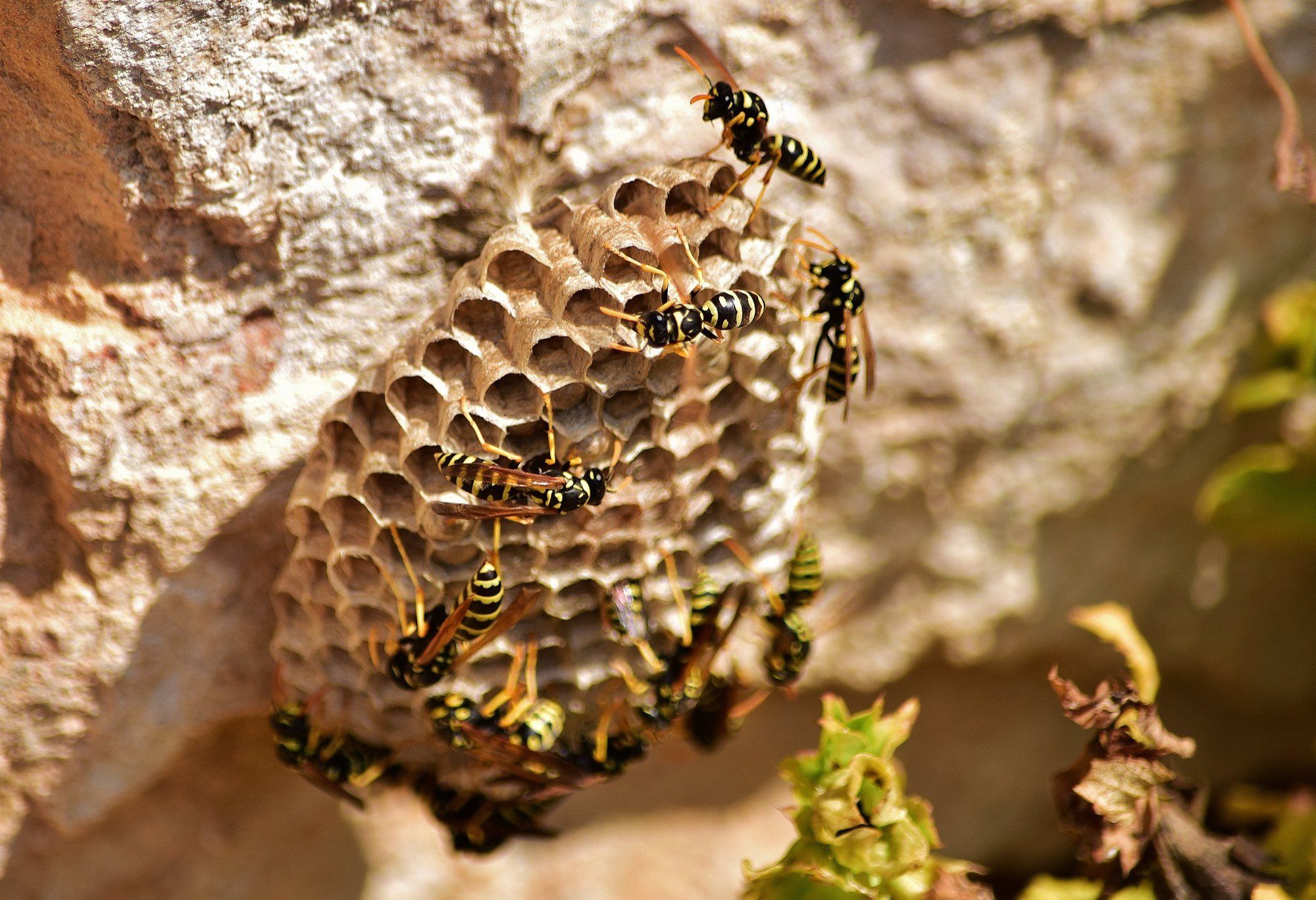In the intricate dance of nature, wasps play a pivotal role. Yet, their presence in our immediate surroundings, especially when they decide to establish a wasp nest, can be a cause for concern. The wasps, with their notorious sting, are not only a nuisance but can pose genuine threats to those allergic.
The challenge isn’t merely about spotting these nests; it’s about understanding the nuanced steps on how to safely and effectively remove them.
How to Get Rid of a Wasp Nest
Using Essential Oils
Targeting the pressing concern of how to get rid of wasp nest, essential oils emerge as a compelling solution. Extracted from botanical sources, they have inherent qualities that make them unpalatable to pests like the persistent wasp.
For instance, the intense fragrance of peppermint oil is not to the liking of wasps. It stands out as a front-runner in strategies on how to get rid of wasp nest. By creating a mixture of diluted peppermint oil and water and administering it around the nest’s area, preferably during the dusk when wasps are at their least active, one can observe notable deterrence.
Similarly, the robust odors of lemongrass and eucalyptus oils serve as formidable obstacles for these winged intruders. These scents effectively dissuade wasps from settling and nesting. However, it’s crucial to tread carefully with this approach. Despite the eco-friendly nature of essential oils, one must be vigilant not to agitate the wasps during its application.
The Power of Smoke
Smoke, inherently suffocating, impedes the wasps’ ability to breathe. Directed aptly at a wasp nest, it triggers an instinctual exodus, driving the occupants to abandon their abode. For those wrestling with the dilemma of how to get rid of wasp nest, the use of smoke emerges as a green and chemical-free approach, standing in stark contrast to synthetic deterrents.
Yet, this method requires finesse. It’s imperative to maintain a consistent, thick stream of smoke to ensure its thorough spread throughout the nest. While the principle seems simple, the practice requires vigilance, given the potential for wasps to become aggressive during the process. Implementing this method during the subdued hours of dusk can further optimize its effectiveness.
Soapy Water Technique
The efficacy of this method is anchored in the soap’s surfactant nature. When soapy water makes contact with wasps, it obstructs their breathing tubes, effectively immobilizing them. For those seeking insights on how to get rid of wasp nest without venturing into hazardous chemicals, a blend of water and liquid soap, when administered with precision to the nest, can dramatically curtail wasp presence.
Yet, precision is key. The concoction must strike the right balance to ensure its potency, avoiding extremes of dilution or concentration. Additionally, choosing the right moment for application is crucial, early morning or late evening, periods of wasp dormancy, are recommended.
Hang Wasp Deterrents
Wasp deterrents, designed to resemble authentic wasp nests, leverage the deeply territorial instincts of wasps. When these insects encounter the decoys, they interpret them as habitats of potential adversaries. Driven by their natural tendency to avoid close proximity to competing colonies, they’re deterred from establishing nests nearby. Hence, for those exploring avant-garde techniques on how to get rid of wasp nest, these deterrents offer a method that harmonizes with nature while avoiding direct confrontation.
Yet, success hinges on meticulous deployment. These deterrents must be prominently positioned in wasp-frequented zones. Regular oversight and upkeep of these tools are also vital to preserve their deterring capabilities.
Call a Professional Pest Control Company
When navigating the complex maze of how to get rid of wasp nest, procuring the services of a seasoned pest control company is a sagacious decision, ensuring thorough resolution with minimal risks.
Such professionals are armed with an array of advanced tools and a deep reservoir of knowledge, enabling them to pinpoint, address, and eliminate wasp nests with unmatched precision. Their methodologies, honed through rigorous training, offer an unparalleled advantage in neutralizing even the most stubborn of wasp colonies. For those wrestling with the conundrum of how to get rid of wasp nest, these specialists deliver a fusion of theoretical expertise and hands-on experience.
Beyond mere eradication, the emphasis of professional services is on holistic safety. This aspect, occasionally sidestepped in amateur endeavours, is central to expert operations, ensuring the well-being of both property occupants and the surrounding ecosystem.
Risks of Ignoring a Wasp Nest
Increased Wasp Population
Wasps, in the grand scheme of ecological balance, play a crucial role, acting as natural pest controllers and aiding in plant pollination. Yet, when their nesting grounds venture too close to human spaces, challenges arise.
Intrinsically, wasps exhibit a robust reproductive cycle. An unattended nest rapidly evolves into a bustling epicenter. Within this hive of activity, the reigning queen produces a multitude of offspring, each predestined to mature into active wasps. Overlooking such a nest doesn’t merely preserve its status, it inadvertently sponsors the growth of a vast wasp empire, complicating eventual removal efforts.
Additionally, as this populace reaches saturation, the colony tends to fragment, birthing subsidiary nests in proximity. This amplifies the initial challenge, morphing a singular concern into a widespread invasion.
Threat to Family and Pets
While wasps aren’t naturally belligerent, they exhibit pronounced protective instincts when their nest is at risk. This implies that a naive child, an elderly individual, or a household pet venturing too near a nest might unintentionally incite a wasp attack. The consequences? A series of venomous stings which, beyond inducing acute pain, can escalate to severe allergic manifestations or, in extreme cases, life-threatening anaphylaxis.
Furthermore, pets, governed by their intrinsic inquisitiveness, are particularly at risk. Their instinct to investigate can inadvertently lead them into the epicenter of a wasp dominion, eliciting a fierce counteraction from the resident wasps. The fallout can be dire, with pets enduring numerous stings that necessitate immediate medical intervention.
Potential for Structural Damage
Certain wasp species, especially those that bore into wood, are consummate builders, repurposing available resources for their domiciles. While this ingenuity is commendable in nature, within human structures, it translates into stealthy degradation. These wasps meticulously gnaw at wood, extracting cellulose to mold their papery nests, imperceptibly undermining the robustness of wooden frameworks, panels, and foundational supports.
Also, the continuous expansion and weight of an enlarging nest can strain and deform infrastructural elements, leading to both cosmetic and functional aberrations. The ambient moisture brought by the wasps’ activities can also hasten wood rot, escalating the erosion of architectural integrity.
The Risk of Allergic Reactions
Wasps, if agitated or cornered, can retaliate with a barrage of venom-laden stings. While these encounters are excruciating for the majority, for a select few, they can catalyze intense allergic reactions. This heightened sensitivity, known as anaphylaxis, is an immediate and potent immune reaction, exhibiting a gamut of symptoms from hives and facial swelling to breathing difficulties and heart complications.
Compounding this challenge is the unpredictability of these allergic reactions. Many might remain oblivious to their vulnerability until an unfortunate encounter. And with each subsequent sting, the odds of an escalated allergic response amplify, rendering an unchecked wasp nest a ticking time bomb.






0 Comments